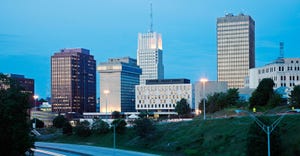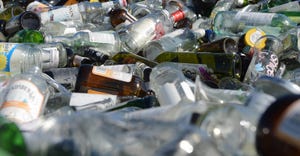Santa Barbara County Co-Locates Dirty MRF, Anaerobic Digester, and Compost
California’s SB 1383 mandates diverting 75 percent of organic waste by 2025, and Santa Barbara County has responded with an innovative facility at Tajiguas Landfill, combining a materials recovery facility (MRF), anaerobic digester, and composting to meet this target. This system not only significantly reduces landfill waste but also generates renewable energy and lowers carbon emissions by efficiently sorting and processing organic materials.

California’s SB 1383 calls on the state to divert 75 percent of organics by 2025—that’s tens of millions of tons of food scraps, green waste, and paper. Decades ahead of that law, Santa Barbara County began conceptualizing ways to divert more and, finally, in 2021, launched a novel resource recovery facility at Tajiguas Landfill. It’s a co-located dirty materials recovery facility (MRF), anaerobic digester, and compost operation.
The MRF itself recovers more than 50 percent of the community’s organic garbage. By January 2025, the county expects that figure to reach SB 1383’s mandated 75 percent target.
“With these co-located facilities, we are reducing what we landfill. That’s one success. But in pulling out organics we are also increasing the renewable energy we generate from them, while greatly reducing the carbon impact of our trash,” says Carlyle Johnston, project leader at the County of Santa Barbara’s public works department.
Dirty MRFs, which take in mixed waste and separate organics and nonorganic recyclables, had a bad name for years. They couldn’t efficiently manage contaminants. But as jurisdictions look for innovative ways to cut waste, especially organics, these facilities are gaining traction. It’s happening with the help of better sorting technology that’s ramped up their performance.
Here’s how Santa Barbara’s multi-facility system works: materials are separated by size and weight at the MRF. A shredder reduces large items into more manageable sizes, then further separates smaller items. Optical sorters separate plastics; magnets pull metals; and an eddy current sorts aluminum.
The organics and the smaller nonorganic pieces left behind move on to the anaerobic digester. The contaminants—about 20 to 25 percent by weight—run through the digester. After the digestate exits, a series of screens further separate plastics, and a vibrating table shakes out glass and rocks to produce compost that’s sold mainly to orchards.
“It may seem impossible, and I did not think at first it was something you could do. But when I went to San Jose and visited facilities there, I saw they could take material that looked like garbage and turn it into compost. And it’s working well for us too,” Johnston says.
About half of what Santa Barbara residents throw out is organics. While they have a bin for recyclables and one for green waste, they have none for food waste, presenting a real contamination problem.
Through its research the county found that this envisioned resource recovery facility was a strong contender as a potential solution. Studies showed dirty MRFing tends to recover more organics than doing curbside collections, Johnston says.
The MRF is not fully operational yet. At this fairly early juncture the separated nonorganics are landfilled, though it’s a relatively small fraction given that most recyclables end up in the blue bins.
With such a large share of what’s in peoples’ trash cans being organics, it’s easy to focus more heavily on pulling out and making use of this fraction, Johnston says, and of course the regulatory pressure is a motivator. Though as the County homes in on the high-methane-emitting streams, it is looking into outlets for other materials, mainly glass to go into road base or concrete.
Once the anaerobic digester is fully operational it will generate about 18,000 MWh per year of electricity. And the resource recovery facility should divert 65,000 tons a year; up from roughly 40,000 tons that were diverted in 2023.
Santa Barbara recently upgraded the facility’s compost component from an open windrow system, involving turning piles, to a covered (GORE) forced aeration system, which Johnston says has resolved an odor problem; generates more consistent product; and speeds up the curing process.
“Once the incoming material has been decontaminated, our technology optimizes aeration and moisture control. By controlling moisture and optimizing the intermittent flow of air with Sustainable Generation’s compost control system and GORE cover, we create an ideal environment for the biological process,” says Scott Woods, founder and CEO of Sustainable Generation, a compost system developer.
The GORE cover, combined with positive aeration and Sustainable Generation’s compost control system, are proven to reduce both odors and volatile organic compound emissions by more than 95 percent compared to open windrow composting. These results have been reproduced in multiple feedstocks, including food waste, biosolids, and digestate, according to Woods.
BEKON Energy Technologies delivers Santa Barbara’s anaerobic digestion system; its fermentation process can manage materials with more than 30 percent dry content.
The system tends to work well in dirty MRFs, says Ignacio Benitez, sales director at BEKON Energy Technologies.
“The process is highly robust due to the concrete construction of its biodigesters and the absence of agitators or pumps within the fermenter. This design enables the system to handle stones or solid contaminants without risking damage to the process or digester components,” he explains.
The high volumes of damaging contaminants in municipal solid waste challenge most technologies. Many of them require the addition of water to treat the organic fraction and protect system components.
Given BEKON’s ability to manage this tough stream’s impurities, plant up-time is about 99 percent and maintenance costs are low compared to other technologies, Benitez says.
Co-locating these facility types seems to pay off for operators going this route. There is no need to transport organic matter elsewhere after it is separated at the MRF. And placing anaerobic digesters and composting next to each other reduces both time and logistical costs, streamlining the entire operation.
Woods confers and pauses on the compost and anaerobic digester components, noting that the anaerobic digestion industry initially assumed that digestate produced at the end of the digestion process was a final product.
“The realities didn’t play out that way. The industry is now realizing that the digestate must be further processed to reduce odors and create a marketable product. Many anaerobic digestion facilities are asking us to assist them in solving their digestate odor and end product problems. New projects are beginning to include composting in their design plans and financial models,” he says.
In California, SB 1383 continues pushing for more infrastructure innovations to process organic material.
“Jurisdictions are and will be looking into building more facilities like the ones in Santa Barbara County,” Johnston says.
About the Author
You May Also Like


.png?width=300&auto=webp&quality=80&disable=upscale)

